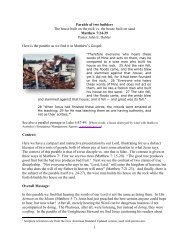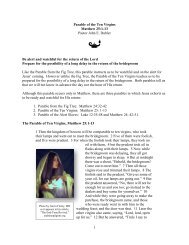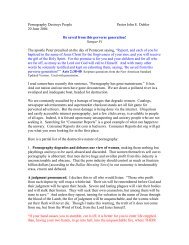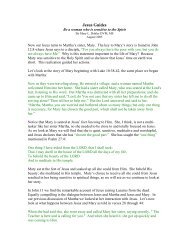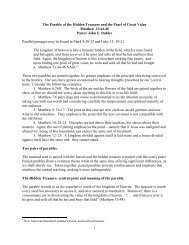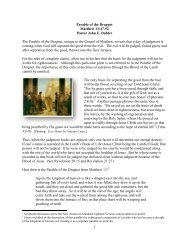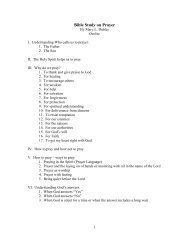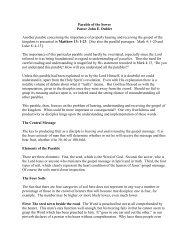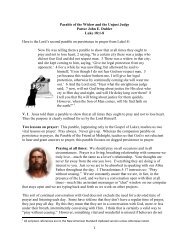Parable of the Wheat and Tares - Pastor John Dubler
Parable of the Wheat and Tares - Pastor John Dubler
Parable of the Wheat and Tares - Pastor John Dubler
Create successful ePaper yourself
Turn your PDF publications into a flip-book with our unique Google optimized e-Paper software.
<strong>Parable</strong> <strong>of</strong> <strong>the</strong> <strong>Wheat</strong> <strong>and</strong> <strong>Tares</strong><br />
Mat<strong>the</strong>w 13: 24-30; 36-43<br />
This parable <strong>of</strong> our Lord Jesus appears only in <strong>the</strong> Gospel <strong>of</strong> Mat<strong>the</strong>w. Even though <strong>the</strong><br />
Lord Himself clearly explains <strong>the</strong> parable, notably telling us that “<strong>the</strong> field is <strong>the</strong> world<br />
(Mat<strong>the</strong>w 13: 38), <strong>the</strong> matter is none<strong>the</strong>less much debated. It is truly amazing how many<br />
commentators disregard <strong>the</strong> Lord’s explanation <strong>and</strong> tell us that <strong>the</strong> field is <strong>the</strong> church.<br />
But this is not a parable about false saints within <strong>the</strong> church, it is a parable about evil in<br />
<strong>the</strong> world. It is not a parable which tells us not to perform church discipline (allow both<br />
to grow toge<strong>the</strong>r until <strong>the</strong> harvest), for <strong>the</strong>re are substantial references elsewhere that tell<br />
us what to do with <strong>the</strong> “hidden reefs in [our] love feasts” (Jude 12), <strong>and</strong> <strong>the</strong> immoral ones<br />
among us (1 Corinthians 5:1).<br />
Fortunately, for us, an explanation <strong>of</strong> <strong>the</strong><br />
parable spoken to <strong>the</strong> multitudes in<br />
Mat<strong>the</strong>w 13: 24-30 follows hard on <strong>the</strong><br />
heels <strong>of</strong> <strong>the</strong> <strong>Parable</strong> <strong>of</strong> <strong>the</strong> Mustard Seed<br />
<strong>and</strong> <strong>the</strong> Leaven. The explanation, found<br />
in verses 36-43, is separated from <strong>the</strong><br />
body <strong>of</strong> <strong>the</strong> parable because Mat<strong>the</strong>w,<br />
preserving for us a sense <strong>of</strong> his<br />
eyewitness testimony, relates <strong>the</strong> Mustard<br />
Seed <strong>and</strong> <strong>the</strong> Leaven parables at <strong>the</strong> place<br />
<strong>and</strong> time <strong>the</strong>y were told by <strong>the</strong> Lord.<br />
Later on, with those additional parables<br />
spoken, He left <strong>the</strong> crowds <strong>and</strong> went into<br />
<strong>the</strong> house with <strong>the</strong> disciples following Him. It was in <strong>the</strong> house, away from <strong>the</strong> crowds,<br />
that <strong>the</strong> disciples asked for an explanation <strong>of</strong> <strong>the</strong> <strong>Parable</strong> <strong>of</strong> <strong>the</strong> <strong>Wheat</strong> <strong>and</strong> <strong>Tares</strong>. How<br />
<strong>of</strong>ten we wish <strong>the</strong> original 12 would have asked that He explain <strong>the</strong>m all.<br />
Therefore, <strong>the</strong> body <strong>of</strong> <strong>the</strong> parable is spoken to <strong>the</strong> crowd while <strong>the</strong> explanation is spoken<br />
only to <strong>the</strong> disciples. Thus, <strong>the</strong> Lord, <strong>of</strong> necessity being on His guard when speaking to<br />
<strong>the</strong> crowds, was able to specifically instruct His disciples without casting His pearls<br />
before a divided multitude, where both dogs <strong>and</strong> swine were listening, not with pure<br />
hearts, but seeking an opportunity to ensnare Him (Mat<strong>the</strong>w 7:6).<br />
<strong>Parable</strong>s veil or conceal <strong>the</strong> truth. They do not make matters more clear to hearers, as<br />
asserted by some. Even <strong>the</strong> disciples had to ask for an explanation. But why conceal <strong>the</strong><br />
truth from <strong>the</strong> sincere seekers who are not among <strong>the</strong> twelve? The presence <strong>of</strong> those dogs<br />
<strong>and</strong> swine in <strong>the</strong> context <strong>of</strong> <strong>the</strong> larger crowd, make any o<strong>the</strong>r course impossible. Besides,<br />
<strong>the</strong> veil is soon enough lifted when <strong>the</strong> sincere seeker begins to earnestly inquire <strong>of</strong> <strong>the</strong><br />
Lord. The Holy Spirit is our teacher, <strong>and</strong> He will guide us into all truth (<strong>John</strong> 16:13).<br />
Sincere seekers will not give up until <strong>the</strong>y finally underst<strong>and</strong>, while <strong>the</strong> casual <strong>and</strong><br />
insincere will quit <strong>the</strong> hunt <strong>and</strong> fade away.<br />
1
The overall Meaning <strong>of</strong> <strong>the</strong> <strong>Parable</strong>. The message is this: Righteous believers <strong>and</strong><br />
wicked people will exist in <strong>the</strong> world until <strong>the</strong> day Jesus returns at <strong>the</strong> end <strong>of</strong> <strong>the</strong> age, <strong>and</strong><br />
<strong>the</strong> final harvest takes place. Until that glorious day, we are not to try to separate out <strong>the</strong><br />
salt <strong>and</strong> light from <strong>the</strong> deteriorating body which is <strong>the</strong> world. We are not to withdraw<br />
ourselves to a fortified castle, prepared to fight <strong>of</strong>f <strong>the</strong> attack <strong>of</strong> <strong>the</strong> world, waiting out <strong>the</strong><br />
return <strong>of</strong> <strong>the</strong> Lord. Despite <strong>the</strong> presence <strong>of</strong> those nasty evil weeds (people), <strong>the</strong> crop will<br />
mature. Good will not be overcome by evil. The righteous will not be eliminated by <strong>the</strong><br />
enemy’s tactic to sow evil seed in God’s field. Also, <strong>the</strong> source <strong>of</strong> evil in <strong>the</strong> world is<br />
clearly spelled out in <strong>the</strong> parable. “An enemy has done this.”<br />
The elements <strong>of</strong> <strong>the</strong> parable. Here are <strong>the</strong> terms <strong>of</strong> <strong>the</strong> <strong>Wheat</strong> <strong>and</strong> <strong>Tares</strong> as defined by<br />
our Lord in Mat<strong>the</strong>w 13: 36-43.<br />
A. Who is <strong>the</strong> sower? Jesus identifies <strong>the</strong> sower as Himself in verse 37: “The<br />
one who sows <strong>the</strong> good seed is <strong>the</strong> Son <strong>of</strong> Man . . .” “Son <strong>of</strong> Man” is commonly<br />
understood as a messianic title which Jesus uses, along with “Son <strong>of</strong> David.”<br />
B. The field: “ . . . <strong>and</strong> <strong>the</strong> field is <strong>the</strong> world . . .” (verse 38). As I previously<br />
observed, “<strong>the</strong> world” does not mean <strong>the</strong> church. No matter how one might try to apply<br />
this parable to those in <strong>the</strong> church, <strong>the</strong> text only supports “<strong>the</strong> field is <strong>the</strong> world.” All<br />
o<strong>the</strong>r interpretations will lead to false applications <strong>of</strong> o<strong>the</strong>r elements <strong>of</strong> <strong>the</strong> parable.<br />
C. The good seed: “ . . . <strong>and</strong> as for <strong>the</strong> good seed, <strong>the</strong>se are <strong>the</strong> sons <strong>of</strong> <strong>the</strong><br />
kingdom . . .” (verse 38). Whatever good seed <strong>the</strong>re may be, those redeemed souls who<br />
acknowledge Jesus as both Savior <strong>and</strong> Lord <strong>of</strong> <strong>the</strong>ir lives <strong>and</strong> live <strong>the</strong>ir words, such seed<br />
is sown by <strong>the</strong> Son <strong>of</strong> Man <strong>and</strong> Him only. The good seed is not sown by Mohamed,<br />
Buddha, Confucius or ourselves (by evolving into a more <strong>and</strong> more perfect existence by<br />
our own will). These good seeds sown into <strong>the</strong> world, meaning <strong>the</strong>y are planted by <strong>the</strong><br />
Lord in every place upon earth. They sprout up all over <strong>the</strong> place, from l<strong>and</strong>s under <strong>the</strong><br />
rule <strong>of</strong> iron fisted dictatorships to <strong>the</strong> shores <strong>of</strong> benevolent democratic republics.<br />
D. And as for <strong>the</strong> tares: <strong>the</strong>y are “<strong>the</strong> sons <strong>of</strong> <strong>the</strong> evil one” (verse 38). An<br />
examination <strong>of</strong> verse 41 reveals two synonyms: Stumbling Blocks <strong>and</strong> Lawless Ones.<br />
“The Son <strong>of</strong> Man will send forth his angels <strong>and</strong> <strong>the</strong>y will ga<strong>the</strong>r out <strong>of</strong> his kingdom all<br />
stumbling blocks <strong>and</strong> those who commit lawlessness . . .” These people may look like<br />
believers, but <strong>the</strong>y are not. Not even <strong>the</strong> safe haven <strong>of</strong> <strong>the</strong> church will protect <strong>the</strong>m when<br />
<strong>the</strong> end comes. And, although <strong>the</strong>y may be hard to distinguish from believers now, in<br />
time <strong>the</strong>ir true nature will manifest itself, making <strong>the</strong>ir identity an easy matter. These are<br />
<strong>the</strong> false prophets <strong>of</strong> Mat<strong>the</strong>w 7:15-20.<br />
What should we do about <strong>the</strong>m? Nothing. Let <strong>the</strong>m grow along with us. Their true<br />
natures will become as evident as grapes versus thorns <strong>and</strong> figs versus thistles.<br />
E. The enemy who sowed <strong>the</strong>m [<strong>the</strong> tares] is <strong>the</strong> devil. More about this presently<br />
in <strong>the</strong> exposition section.<br />
F. The harvest is <strong>the</strong> end <strong>of</strong> <strong>the</strong> age. The world is not yet ready to be reaped, but<br />
someday, <strong>and</strong> perhaps soon, <strong>the</strong> “Lord will descend from heaven with a shout, with <strong>the</strong><br />
voice <strong>of</strong> <strong>the</strong> archangel <strong>and</strong> with <strong>the</strong> trumpet <strong>of</strong> God . . .” (1 Thessalonians 4:16).<br />
G. The reapers are angels. The angels <strong>of</strong> Revelation await <strong>the</strong>ir comm<strong>and</strong> to reap<br />
<strong>the</strong> earth (Revelation 14:14 <strong>and</strong> following).<br />
2
Exposition <strong>of</strong> <strong>the</strong> parable. Mat<strong>the</strong>w13: 24-25 “While his men were sleeping his enemy<br />
came <strong>and</strong> sowed tares among <strong>the</strong> wheat <strong>and</strong> went away.” The men were not sleeping<br />
because <strong>the</strong>y were lazy, but ra<strong>the</strong>r because it was <strong>the</strong> normal time to sleep. However, <strong>the</strong><br />
enemy is very clever <strong>and</strong> full <strong>of</strong> deceit. He does not approach during <strong>the</strong> daylight, but<br />
lurks in night shadows, steals in to <strong>the</strong> field <strong>and</strong> sows <strong>the</strong> weed seed in stealth <strong>and</strong><br />
perfidy. He prefers darkness. We “are all sons <strong>of</strong> light <strong>and</strong> sons <strong>of</strong> day, we are not <strong>of</strong><br />
night nor <strong>of</strong> darkness” (1 Thessalonians 5:5). Once <strong>the</strong> damage has been done, he slips<br />
back into <strong>the</strong> night <strong>and</strong> disappears.<br />
The devil sowed tares into <strong>the</strong> field where <strong>the</strong> good seed were already sown. These tares<br />
represent evil or evil people in <strong>the</strong> world. The volumes on <strong>the</strong> source <strong>of</strong> evil in <strong>the</strong> world<br />
must number in <strong>the</strong> tens <strong>of</strong> thous<strong>and</strong>s. In our own<br />
time we frequently take note <strong>of</strong> books which<br />
attempt to answer <strong>the</strong> question, “Why do bad things<br />
happen to good people?” Those with a Biblical<br />
perspective on <strong>the</strong> question will always come back<br />
to this: “an enemy has done this.”<br />
<strong>Wheat</strong> <strong>and</strong> <strong>Tares</strong><br />
Therefore, we cannot <strong>and</strong> should not blame God for<br />
<strong>the</strong> fact that tares are growing alongside wheat in<br />
<strong>the</strong> world. God is infinite in purity <strong>and</strong> holiness.<br />
He is full <strong>of</strong> goodness <strong>and</strong> would never be <strong>the</strong> one<br />
to sow evil into <strong>the</strong> world. Ra<strong>the</strong>r <strong>the</strong> enemy,<br />
Satan, has done this.<br />
Satan is he who sows evil, discord, disharmony,<br />
division <strong>and</strong> evil followers <strong>the</strong>mselves in to <strong>the</strong><br />
world. He is <strong>the</strong> fa<strong>the</strong>r <strong>of</strong> lies <strong>and</strong> <strong>the</strong> fa<strong>the</strong>r <strong>of</strong> all<br />
evil ones. God is not <strong>the</strong> fa<strong>the</strong>r <strong>of</strong> anyone who practices evil. But when Jesus addressed<br />
<strong>the</strong> Pharisees He flatly declared, “You are <strong>of</strong> your fa<strong>the</strong>r <strong>the</strong> devil, <strong>and</strong> you want to do <strong>the</strong><br />
desires <strong>of</strong> your fa<strong>the</strong>r” (<strong>John</strong> 8:44).<br />
[Photo: Bearded Darnell (top) compared to wheat—by <strong>John</strong> <strong>Dubler</strong>]<br />
The Bible speaks <strong>of</strong> mysteries, one <strong>of</strong> <strong>the</strong>m being <strong>the</strong> “Mystery <strong>of</strong> Iniquity.” “For <strong>the</strong><br />
mystery <strong>of</strong> lawlessness [iniquity] is already at work; only he who now restrains will do so<br />
until he is taken out <strong>of</strong> <strong>the</strong> way.” 2 Thessalonians 2:7<br />
The tares are, in reality, a troublesome sprout which resembles wheat in <strong>the</strong> early stages,<br />
but once <strong>the</strong> wheat heads up it becomes obvious that <strong>the</strong> tares are imposters <strong>and</strong> not<br />
genuine wheat. The tares are sometimes referred to as “wild oats.” In North America<br />
<strong>the</strong>se wheat imposters are actually Bearded Darnel. The weed is not poisonous, <strong>and</strong> may<br />
be eaten without harm to humans. But in <strong>the</strong> field it causes havoc. Sucking up vital soil<br />
nutrients <strong>and</strong> moisture, <strong>the</strong>y deprive <strong>the</strong> wheat plants <strong>of</strong> what was intended for <strong>the</strong>m. The<br />
Bearded Darnel also plays host to Ergot Smut fungus, which is deleterious to a healthy<br />
wheat crop.<br />
3
Mat<strong>the</strong>w 13:26. “But when <strong>the</strong> wheat sprouted <strong>and</strong> bore grain, <strong>the</strong>n <strong>the</strong> tares became<br />
evident also.” What is not obvious now will be plain later on, for <strong>the</strong> Lord promises in<br />
<strong>the</strong> <strong>Parable</strong> <strong>of</strong> <strong>the</strong> Lamp (Luke 8:16-18), “For nothing is hidden that will not become<br />
evident, nor anything secret that will not be known <strong>and</strong> come to light.” In Colorado <strong>the</strong><br />
differences become dramatic in late June <strong>and</strong> early July when <strong>the</strong> winter wheat is ready<br />
for harvest. Since today’s wheat plants have been genetically engineered to have less<br />
stalk <strong>and</strong> more prolific grain than in time past, <strong>the</strong> plants at maturity are not very tall—<br />
only about 12-15 inches. The tares, on <strong>the</strong> o<strong>the</strong>r h<strong>and</strong>, keep on growing, poking <strong>the</strong>ir<br />
unproductive heads four or five inches above <strong>the</strong> wheat crop making <strong>the</strong>m easy to<br />
distinguish. Even without this ra<strong>the</strong>r important give-away, <strong>the</strong> end <strong>of</strong> <strong>the</strong> growing cycle<br />
would reveal what is genuine wheat <strong>and</strong> what are weeds. At <strong>the</strong> harvest time Bearded<br />
Darnel resembles wheat like a Chevy resembles a Cadillac.<br />
Mat<strong>the</strong>w 13:17-30. Dealing with <strong>the</strong> problem. The solution given in <strong>the</strong> parable is<br />
remarkably simple, “Allow both to grow toge<strong>the</strong>r until <strong>the</strong> harvest . . .” The wheat <strong>and</strong><br />
tares are allowed to grow toge<strong>the</strong>r in <strong>the</strong> same filed, receiving <strong>the</strong> same amount <strong>of</strong> water<br />
<strong>and</strong> sun. The tares cannot be cultivated nor weeded out without damaging <strong>the</strong> wheat.<br />
The tares cannot simply be uprooted without causing a great deal <strong>of</strong> harm to surrounding<br />
plants. That is because <strong>the</strong> tares have a web-like root structure which moves out<br />
horizontally to ensnare <strong>the</strong> roots <strong>of</strong> as many wheat plants as may be possible. <strong>Wheat</strong>, on<br />
<strong>the</strong> o<strong>the</strong>r h<strong>and</strong>, sends its roots down <strong>and</strong> out, but not as widely as tares.<br />
At harvest <strong>the</strong> wheat is cut <strong>and</strong> threshed along with <strong>the</strong> tares. Bearded Darnel is crushed<br />
<strong>and</strong> blown <strong>of</strong>f with <strong>the</strong> chaff.<br />
Why not root out <strong>the</strong> tares right now? The answer given by <strong>the</strong> l<strong>and</strong>owner is as<br />
applicable today in wheat farming as <strong>the</strong>n, <strong>and</strong> spiritually speaking will be forever. One<br />
who would uproot <strong>the</strong> evil from among <strong>the</strong> good will destroy many good people with <strong>the</strong><br />
evil ones. In <strong>the</strong> process <strong>of</strong> implementing such drastic methods, <strong>the</strong> gates <strong>of</strong> society itself<br />
would be torn down. Chaos would ensue.<br />
The tares are dealt with at <strong>the</strong> harvest; evil is dealt with at <strong>the</strong> end <strong>of</strong> <strong>the</strong> age when Jesus<br />
returns. The Son <strong>of</strong> Man sends forth His reaping angles, <strong>and</strong> in <strong>the</strong> parable we learn that<br />
<strong>the</strong> tares are ga<strong>the</strong>red up first. These are <strong>the</strong> stumbling blocks <strong>and</strong> those who commit<br />
lawlessness (verse 41). Those evil ones are thrown into <strong>the</strong> furnace <strong>of</strong> hell fire.<br />
By contrast, “<strong>the</strong> righteous shine forth as <strong>the</strong> sun in <strong>the</strong> kingdom <strong>of</strong> <strong>the</strong> fa<strong>the</strong>r.” No doubt<br />
<strong>the</strong> trials, tribulations <strong>and</strong> testing <strong>the</strong>y have endured while growing up in <strong>the</strong> world have<br />
burnished <strong>the</strong>ir countenances until <strong>the</strong>y fairly glow. Meanwhile, <strong>the</strong>y too are reaped <strong>and</strong><br />
<strong>the</strong>n stored safely in <strong>the</strong> Lord’s barn. By contrast with <strong>the</strong> fire, we can assume that this<br />
barn is heaven itself.<br />
Do not be surprised to discover that at <strong>the</strong> end <strong>of</strong> <strong>the</strong> age, at harvest time, this entire<br />
world is reaped <strong>and</strong> threshed. It will not be pleasant; no threshing could be. The field<br />
must be harvested sometime before that danger <strong>of</strong> rot to <strong>the</strong> plants becomes too great.<br />
4
Therefore, do not be surprised at any fiery trials now or at <strong>the</strong> end <strong>of</strong> time:<br />
Beloved, do not be surprised at <strong>the</strong> fiery ordeal among you, which<br />
comes upon you for your testing, as though some strange thing<br />
were happening to you; 13 but to <strong>the</strong> degree that you share <strong>the</strong><br />
sufferings <strong>of</strong> Christ, keep on rejoicing, so that also at <strong>the</strong><br />
revelation <strong>of</strong> His glory you may rejoice with exultation. 14 If you<br />
are reviled for <strong>the</strong> name <strong>of</strong> Christ, you are blessed, because <strong>the</strong><br />
Spirit <strong>of</strong> glory <strong>and</strong> <strong>of</strong> God rests on you. 15 Make sure that none <strong>of</strong><br />
you suffers as a murderer, or thief, or evildoer, or a troublesome<br />
meddler; 16 but if anyone suffers as a Christian, he is not to be<br />
ashamed, but is to glorify God in this name. 17 For it is time for<br />
judgment to begin with <strong>the</strong> household <strong>of</strong> God; <strong>and</strong> if it begins with<br />
us first, what will be <strong>the</strong> outcome for those who do not obey <strong>the</strong><br />
gospel <strong>of</strong> God? 18 AND IF IT IS WITH DIFFICULTY THAT THE<br />
RIGHTEOUS IS SAVED, WHAT WILL BECOME OF THE GODLESS<br />
MAN AND THE SINNER? 19 Therefore, those also who suffer<br />
according to <strong>the</strong> will <strong>of</strong> God shall entrust <strong>the</strong>ir souls to a faithful<br />
Creator in doing what is right (1 Peter 4:12-19). 1<br />
In <strong>the</strong> mean time, <strong>and</strong> while we are waiting for <strong>the</strong> reapers, let us take away two lessons<br />
from this parable:<br />
First: We will be side-by-side with worldly <strong>and</strong> ungodly people until <strong>the</strong> very end <strong>of</strong> <strong>the</strong><br />
age. Therefore “let your light shine before men in such a way that <strong>the</strong>y may see your<br />
good works <strong>and</strong> glorify your fa<strong>the</strong>r who is in heaven” (Mat<strong>the</strong>w 5:16). We will, by<br />
God’s grace <strong>and</strong> His power, be in a position to “have mercy on some, who are doubting;<br />
save o<strong>the</strong>rs, snatching <strong>the</strong>m out <strong>of</strong> <strong>the</strong> fire; <strong>and</strong> on some have mercy with fear, hating<br />
even <strong>the</strong> garment polluted by <strong>the</strong> flesh” (Jude 22-23).<br />
Second, let us never lose our perspective on <strong>the</strong> reality <strong>and</strong> origin <strong>of</strong> evil in <strong>the</strong> world:<br />
“An enemy has done this.”<br />
1 New American St<strong>and</strong>ard Updated edition, used with permission.<br />
5



